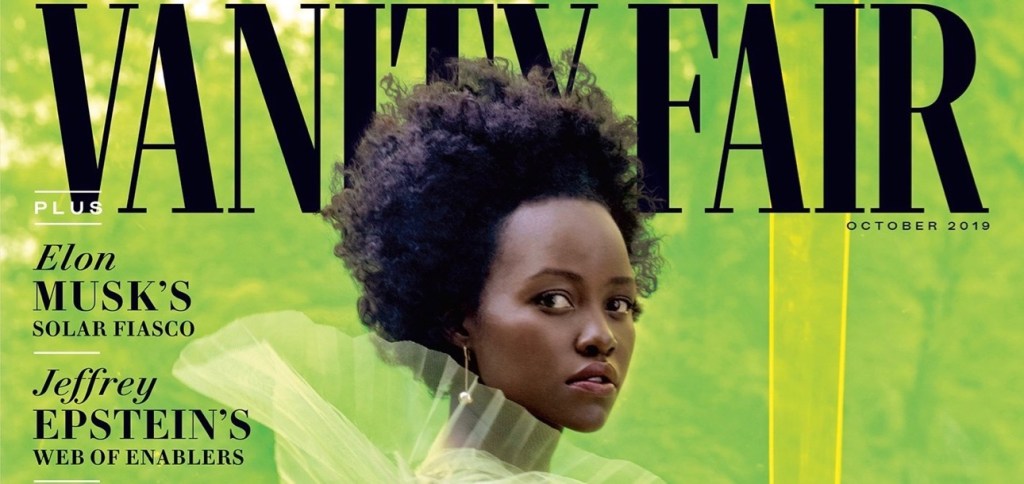This time last year, we were thrilled to report that diversity on the covers of 51 of the top domestic, international and independent fashion magazines had improved significantly between 2017 and 2018. In 2018, a record 37.7 percent of cover castings went to people of color, up from 32.5 percent the year before. That’s a considerable — 5.2 percent — increase. Sadly, from 2018 to 2019 there was no such progress.
In fact, with the exception of age representation, which plateaued, diversity on magazine covers is down across the board.
RACE

Of the 745 cover appearances we reviewed this year — again across 51 leading fashion publications — we found that 275, or 36.9 percent, were people of color, a small but nonetheless disappointing 0.8 percent dip from the aforementioned 37.7 percent seen in 2018.

MOST AND LEAST DIVERSE
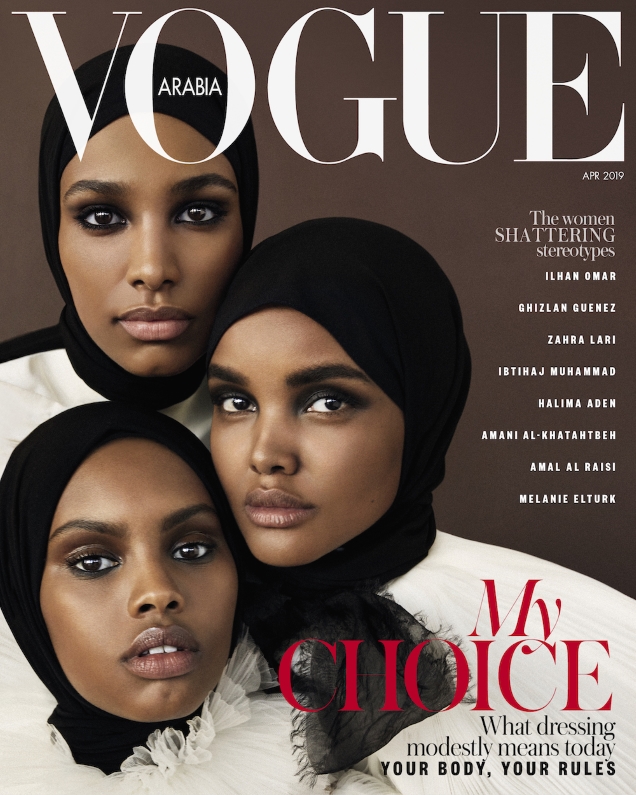
Vogue India (100 percent) and Vogue Taiwan (100 percent) featured the most racial diversity — Vogue Taiwan for the fifth year running. These were closely followed by i-D (83 percent, one non-binary person), Vogue Arabia (80 percent, one woman age 50-plus) and Vogue Mexico (79 percent, including two plus-size women, one of them over age 50).
Next came Vogue Hong Kong (75 percent, including 54-year-old actress and singer Carina Lau), Porter (67 percent), Vogue Brazil (64 percent, one woman age 50-plus), Vogue Thailand (62 percent) and T: The New York Times Style Magazine (60 percent).
V Magazine (57 percent with one plus-size woman), Vogue U.K. (57 percent with one plus-size woman, one trans woman and four women age 50 or above), Marie Claire U.S. (56 percent) and Vogue Japan (52 percent, one woman above age 50) rounded out the list.
We’d like to take a minute to spotlight Vogue U.K. and ELLE U.S. Led by Edward Enninful and Nina Garcia, respectively, the two publications featured better across-the-board diversity than most.
Before 2017, Vogue U.K. went 14 years with only six nonwhite solo cover stars; this year it hired 16 out of 28 nonwhite women, not to mention its first (publicly) transgender cover star. (For the mag’s full list of accomplishments, see above.)
While only 35 percent of ELLE U.S.’s 2019 cover stars had minority heritage, the magazine did hire women from every diversity category: three age 50 or above, two plus-size and, like Vogue U.K., the mag picked its first transgender cover star.
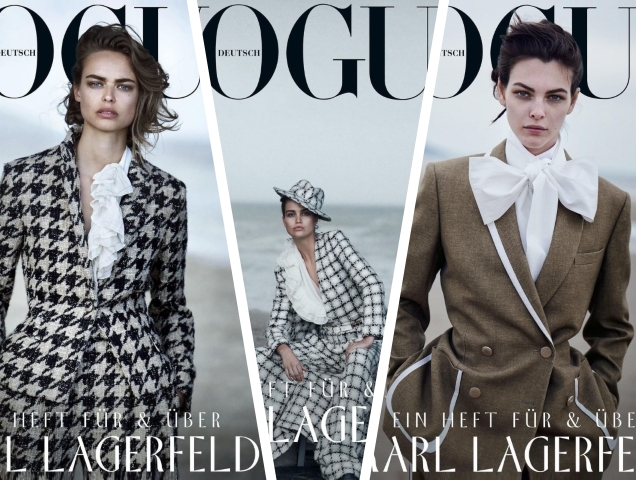
On the opposite end of the spectrum, two of the publications we reviewed — Vogue Poland and The Gentlewoman — featured not a single person of color. Vogues Czech Republic (7 percent), Paris (8 percent), Portugal (8 percent), Germany (10 percent) and Turkey (10 percent) also put out startlingly white covers.
Although, to be fair, a handful of the above did make an effort to showcase other forms of diversity. The Gentlewoman hired two 50-plus cover stars, as did Vogues Portugal, Germany and Czech Republic. And the latter featured trans model Finn Buchanan on its November edition.
What’s more, Vogue Portugal actually made history — and headlines — with its April issue, which starred South African model Thando Hopa, the first woman with albinism to appear on the cover of Vogue. The publication also tapped (plus-size) comedian Celeste Barber for its August cover. So, despite its failure at racial inclusion, we can’t totally condemn the Suzy Menkes-led mag.
PLUS-SIZE
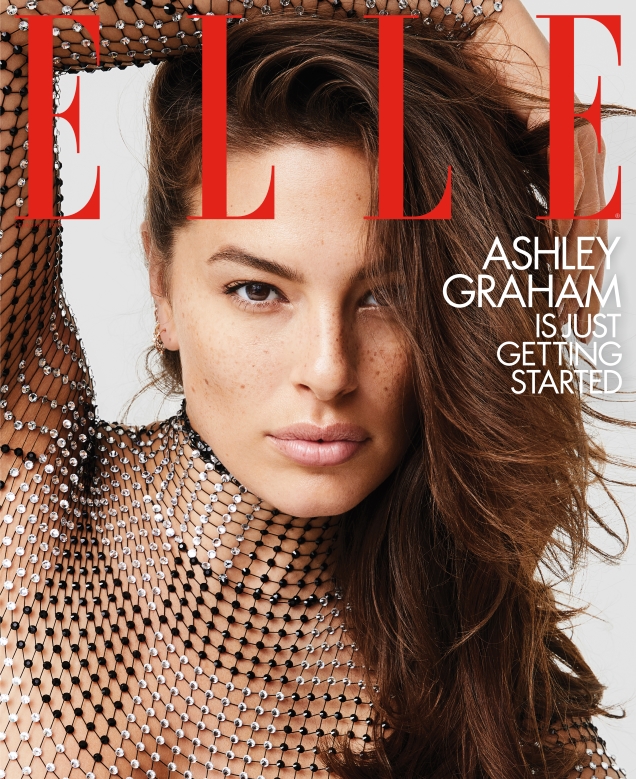
“Plus-size” women — a group that has been sorely underrepresented on newsstands for years — landed 15 (2.01 percent) cover appearances in 2019, three fewer than the year before (2.42 percent). So body diversity on magazine covers took a slight (0.41 percent) hit.
There is, without question, a lot more work to be done on the size inclusivity front. Still, the magazine industry has made definite strides in the right direction. In 2017, we counted just eight (1.02 percent) non-sample-size cover stars; in 2016, only six (0.88 percent).
As to how these numbers stack up against the most recent runway and ad campaign stats, size representation was up last fashion month from 0.69 percent (50 plus-size castings) in Fall 2019 to 1.16 percent (86 castings) in Spring 2020. Meanwhile, body diversity in the seasonal ads fell from 2.08 percent (11 castings) in Spring 2019 to 1.94 percent (9 castings) in Fall 2019. So, compared to other legs of the fashion industry, fashion publications did well in terms of size inclusion in that they at least passed the 2 percent mark.
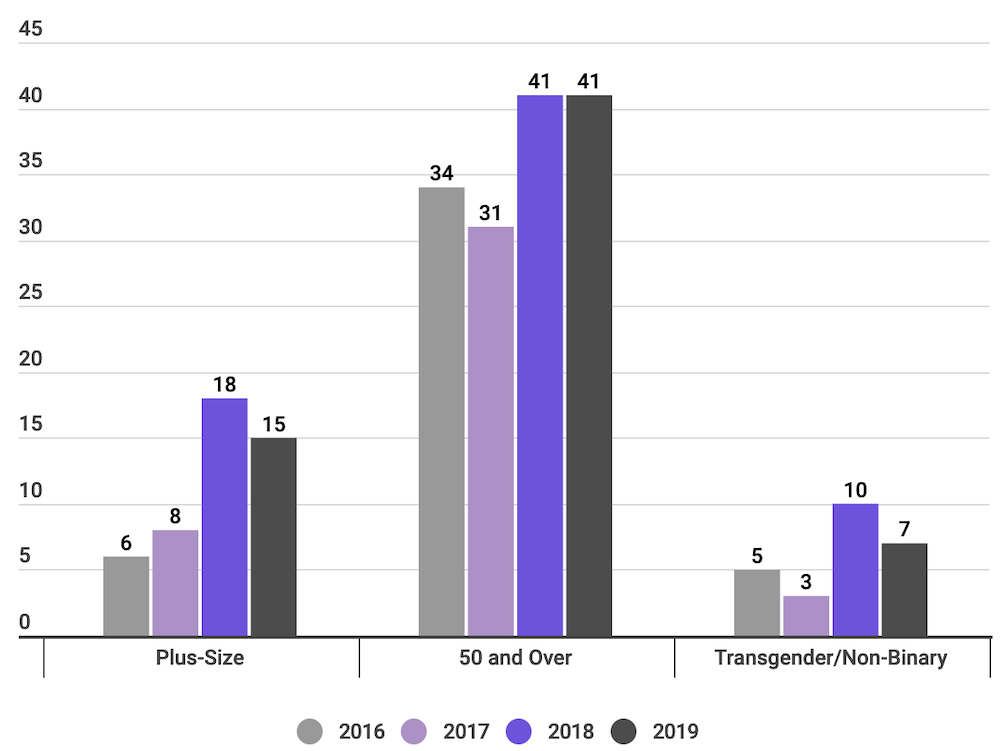
InStyle, Vogue Mexico and ELLE U.S. saw the most body diversity this year with two non-sample-size cover stars each. Actors Melissa McCarthy and Rebel Wilson covered InStyle in February and May, respectively. Vogue Mexico tapped model Paloma Elsesser for its April issue. In October, for its 20th anniversary issue, the publication released six separate covers, each featuring Latinx women known for their stereotype-breaking work in the fields of entertainment, sports, the culinary arts and so on. Among them was Abigail Mendoza, an acclaimed Zapotec chef. As for ELLE U.S., model and podcaster Ashley Graham covered the glossy’s February issue; singer/songwriter/rapper/flutist Lizzo starred on its music-themed October edition.
Speaking of which: within the category, eight-time Grammy nominee Lizzo racked up the most covers of the year. The “Truth Hurts” singer fronted four titles: Vogue U.K., LOVE, V Magazine and, as mentioned, ELLE U.S. Graham followed with three covers (Allure, Harper’s Bazaar U.K. and ELLE U.S.). Trailing her was McCarthy with two cover appearances (InStyle and WSJ. Magazine).
Looking at intersectionality, 7 of the 15 size-inclusive covers went to women of color, one to an indigenous Mexican woman over the age of 50 (Mendoza). The year had no openly transgender or non-binary plus-size cover stars.
AGE
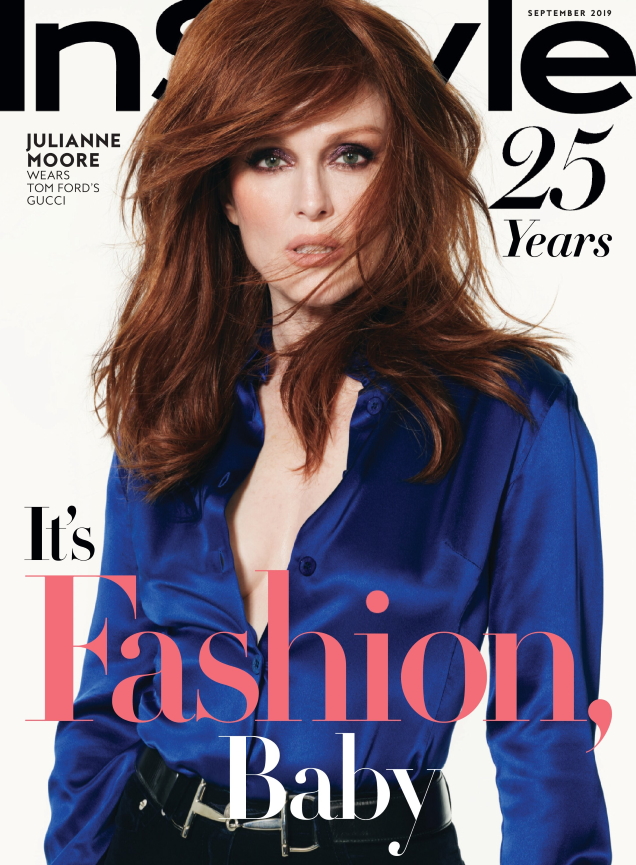
As stated, women age 50 and above were the only group that didn’t suffer a loss in cover representation, but they didn’t make any gains. This year’s covers featured 41 (5.5 percent) women in the age group, matching 2018’s number, which itself was only a minor (0.5 percent) improvement over the 5 percent seen in both 2017 and 2016.
Put plainly, age diversity on magazine covers stayed mostly static for the fourth year in a row. Even so, women in the 50 and over range continue to land more magazine covers than any category outside of race — another four-year trend.
As is typically the case, this year’s magazine covers far outdid the most recent runways and ad campaigns in terms of age representation. (The runways in particular are notoriously age-averse; women age 50 and over are consistently the least-represented group.) Even more discouragingly, we saw little to no progress on the age diversity front in all three arenas.
At the Spring 2020 shows, a total of 39 models (0.53 percent) age 50 and above walked, up from 36 (0.49 percent) the prior season. Fall 2019’s campaigns, meanwhile, featured 10 models (2.16 percent) in the age group, down from Spring 2019’s 15 (2.84 percent).
Once again, Nicole Kidman, 52, racked up the most covers of any woman in this age bracket — six, including Vanity Fair, InStyle, ELLE U.S., Vogue Australia and W (twice). Following her with three covers was Christy Turlington, 50, who covered Vogues U.K., Mexico and Brazil.
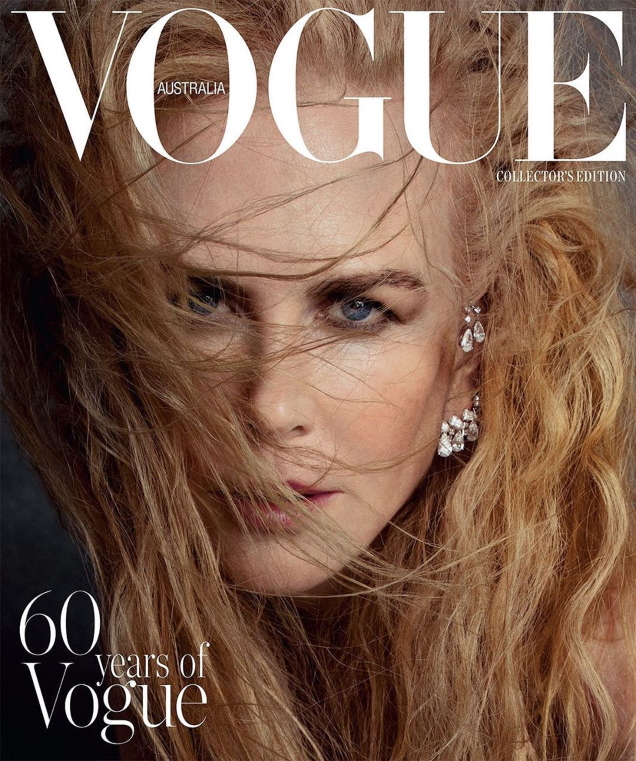
Tied for third place with two covers each were Céline Dion, 51 (CR Fashion Book and ELLE U.S.), Cindy Sherman, 65 (The Gentlewoman and WSJ. Magazine), Demi Moore, 57 (Harper’s Bazaar U.S. and WSJ. Magazine), Julianne Moore, 59 (InStyle and WSJ. Magazine), Laura Dern, 52 (InStyle and Vanity Fair) and Sharon Stone, 61 (Allure and Vogue Portugal).
The rest of the set — which includes legends like Björk, Dolly Parton, Isabella Rossellini, Jane Fonda, Madonna, Margaret Atwood, Miuccia Prada, Pamela Anderson, Salma Hayek, Tilda Swinton and Kris Jenner — landed one cover apiece.
InStyle and Vogue U.K. led in terms of age diversity. Both hired four cover stars age 50 or above: Kidman, Dern, Renée Zellweger and Julianne Moore at InStyle; Madonna, Turlington, Fonda and Hayek at Vogue U.K. WSJ. Magazine, which was responsible for four of last year’s 50-and-over cover appearances, again held up its end, casting Sherman, Demi Moore and Julianne Moore. ELLE U.S. also hired three women age 50 or above (Kidman, Dion and Parton) as did W (Angela Bassett once, Kidman twice).
Finally, we’d like to take a moment to acknowledge the stunning lack of racial inclusion within this category. The vast majority — 37 of 41 or 90.2 percent(!) — of 2019’s age-inclusive covers went to white women. (Although, to reiterate, Vogue Mexico did feature one nonwhite, plus-size woman over the age of 50, Abigail Mendoza.)
TRANSGENDER/NON-BINARY
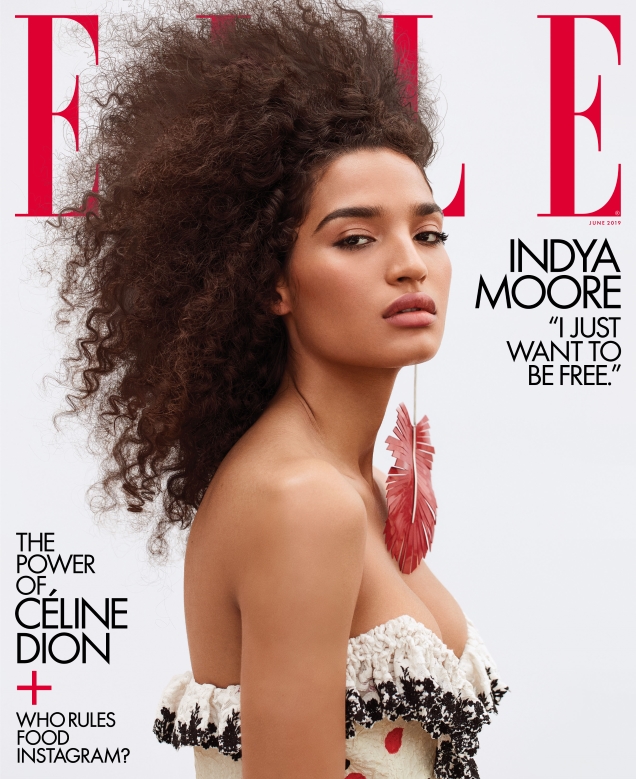
From 2018 to 2019, the number of openly male-to-female transgender and non-binary persons featured on covers fell from 10 (1.34 percent) to seven (0.94 percent). As a result, they were the least represented group, as has always been the case with magazine covers.
This decline is all the more striking given that 2018 was something of a landmark season for gender inclusivity — not only did the number of trans and non-binary cover stars reach an all-time high, it more than tripled from the previous year.
Needless to say, while transgender and non-binary representation in the fashion industry has improved in recent years, it remains low across the board: 46 (0.62 percent) of all Spring 2020 runway castings went to “out” trans or non-binary models, down 0.15 percent from the 56 recorded in Fall 2019; six (1.29 percent) Fall 2019 campaign models belonged to the category, up from two (0.38 percent) the season before. Considering the ever-fluctuating numbers, it’s difficult to say how much real progress is being made.
But the news isn’t all bad: publishers are doing better at addressing tokenism. Whereas back in 2016, four of the year’s five gender-inclusive covers featured actress Hari Nef, this year — for the second year in a row — there was no repetition among the cover choices.
Laverne Cox covered Vogue U.K.’s almighty September issue and in so doing became the magazine’s first transgender cover star. (Again, hat tip to Edward Enninful.) Pose’s Indya Moore did ELLE U.S. the same honor in June. British model Finn Buchanan fronted Vogue Czech Republic’s November edition; Filipinx model Noah Carlos was one of three models to appear on i-D’s Winter 2019 “The Get Up Stand Up” issue. And (non-binary) Björk collaborator Hungry posed alongside top model Rianne Van Rompaey for the cover of WSJ. Magazine’s September fashion issue.
Of the publications we reviewed, Dazed was the only title to hire more than one trans or non-binary cover star. The glossy’s multi-cover Spring 2019 issue — a celebration of “infinite forms of identity, and the creativity of LGBTQIA+ communities everywhere” — featured model Ariel Nicholson and Euphoria’s Hunter Schafer.
An aside: This year Paper, which in 2018 featured the most trans or non-binary cover stars of any title, also hired two trans women (Schafer and Teddy Quinlivan) albeit for digital covers, which we do not consider in our data.
As for the titles that embraced multiple forms of diversity: Vogue U.K., ELLE U.S. and i-D each hired one trans or non-binary person of color (Cox, Moore and Carlos, respectively).
TOP MODELS
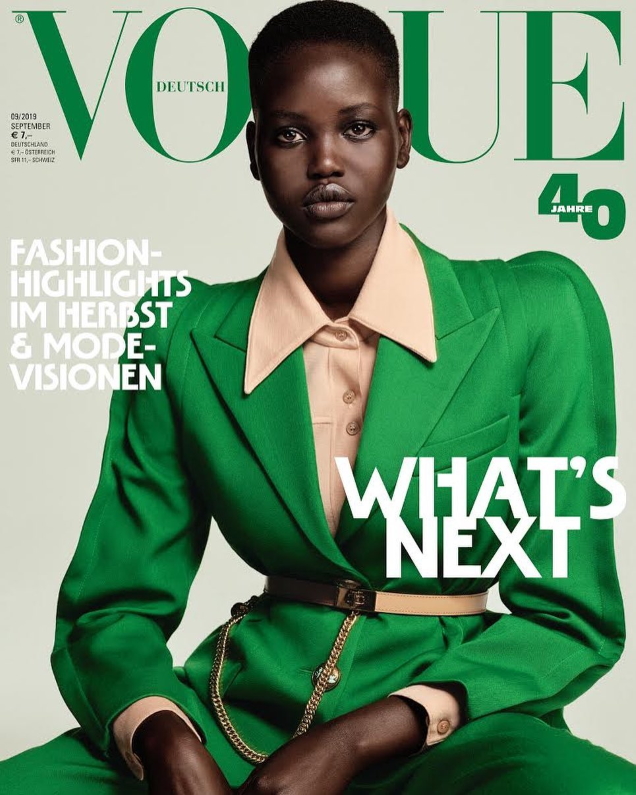
Despite the disappointing declines seen in the categories of race, size and gender diversity and the lack of progress in age inclusivity, 2019’s 10 most-booked cover stars were a noticeably more diverse group than those of years past.
Half of the top 10 were women with minority heritage (although two of those five were the admittedly white-passing Hadid sisters). And, in a rare turn of events, one woman over the age of 50 made the cut.
What’s more, at the head of the pack were a black woman and a mixed-race woman. South Sudanese-Australian model Adut Akech and Dutch-Palestinian-American model Gigi Hadid racked up the most covers of the year with nine each.
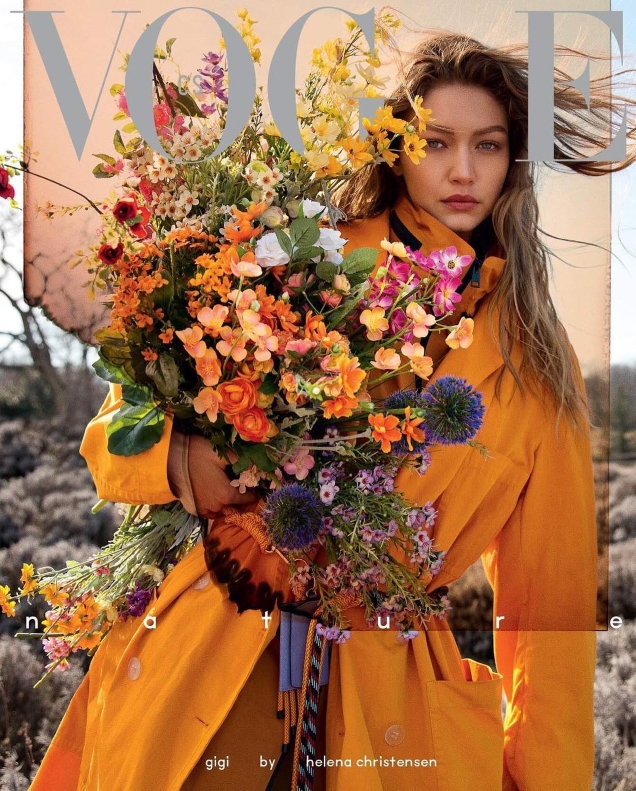
Akech fronted Allure, Dazed and Vogues Germany, Australia, Paris, U.K., Italia and Japan (the latter twice); the elder Hadid covered ELLE U.S., LOVE and several international Vogue editions (Brazil, Germany, Mexico, Arabia, Czech Republic, Hong Kong and Italia).
Second place was a four-way tie between South Sudanese model Anok Yai, Bella Hadid, Dutch model Birgit Kos and Russian model Irina Shayk, each of whom landed seven covers. In third place, with six covers apiece, were modeling legend Naomi Campbell (age 49), Nicole Kidman (age 52), American model Rebecca Leigh Longendyke and Dutch model Rianne Van Rompaey.
Unfortunately, no transgender, non-binary or plus-size models made the top 10. Still, the increasing popularity of cover stars nearing or above the age of 50 is encouraging.
LOOKING FORWARD
So what does all this mean? It’s no secret that the media world is undergoing some major changes. At a time when heavy hitters like Glamour, Teen Vogue and Nylon are ceasing print operations and digital covers — which, as Fashionista explains, “[allow] brands to play with formatting, cast less traditional cover stars and tackle more timely subject matter” — are growing ever more popular, does what we see on the newsstands even carry that much weight?
Whether it does or not, it’s unsettling that in 2019 diversity and inclusion appeared to be somewhat less of a priority to publishers than the year before. Still, bright spots like Laverne Cox’s Vogue U.K. cover, an age-inclusive most-booked list and the year’s many glossy Lizzo sightings give us hope for the coming decade.
With additional reporting by Mark E.
For the purpose of this report, “model” is anyone who appears on a cover, even if modeling is not their profession. Models of color are categorized as those who are nonwhite or of mixed backgrounds.
